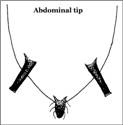Classification
Aphidinae: Aphidini
Diagnosis
The aphid is dull yellowish brown, with head and thorax light brown, eyes, siphunculi and cauda dark brown antennae white with only the last segment dark; legs white with apices of femora, tibia and tarsi dark. Nymphs are covered lightly with wax. Body oval, hairs on tergites long and pointed. Eighth tergite with six hairs as long as those on the vertex. Head sclerotic brownish, tergum colourless. Antenna 0.8x as long as body, I, II and VI brown, the rest pale. Rostrum reaches up to hind coxa. Siphunculi dark and imbricate, about 1/6 the length of body. Cauda dark, tapering, with eight hairs, about 2/3 the siphunculi.
This aphid resembles A. craccivora, but can be differentiated by its yellowish colour.
Distribution
India: Himachal Pradesh, Karnataka, Tamil Nadu, Uttar Pradesh.
Host plant(s)
Punicaceae: Punica granatum L.
Measurements
Aptera: Length of body 1.66, width 1.1; antennae 1.32, segments III: IV: V: VI 0.26: 0.25: 0.21: (0.11+0.25); u.r.s. 0.11; h.t.2 0.12; siphunculus 0.27; cauda 0.17.
Alata: Length of body 2.01, width 1.0; antennae 1.60, segments III: IV: V: VI 0.37: 0.25: 0.20: (0.10+0.26); u.r.s. 0.12; h.t.2 0.11; siphunculus 0.22; cauda 0.15.
Seasonal occurrence
January-March, July-August
Natural enemies
Coleoptera: Coccinellidae: Coelophora biplagiata (Swartz) and Harmonia dimidiata (F.).

